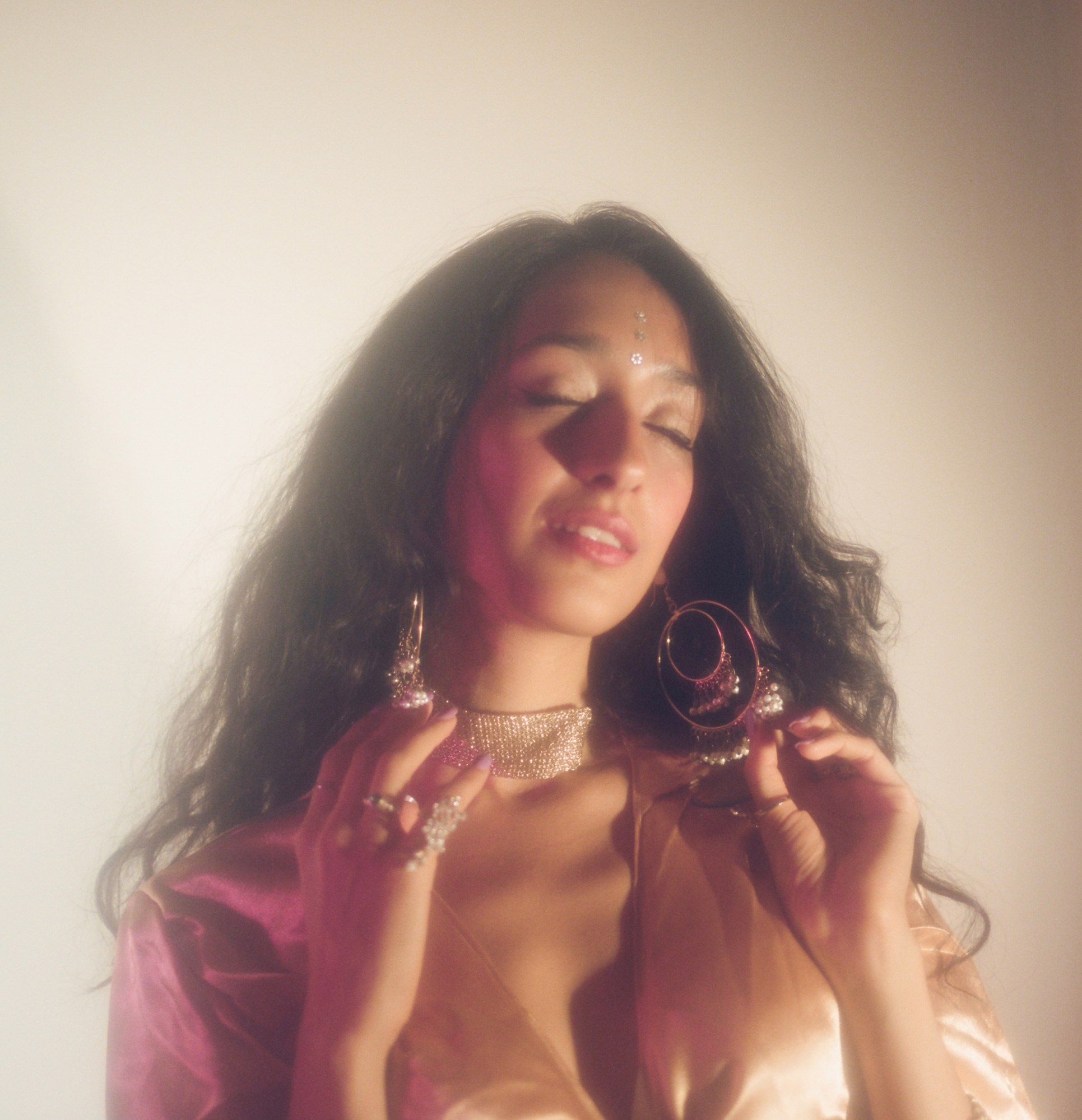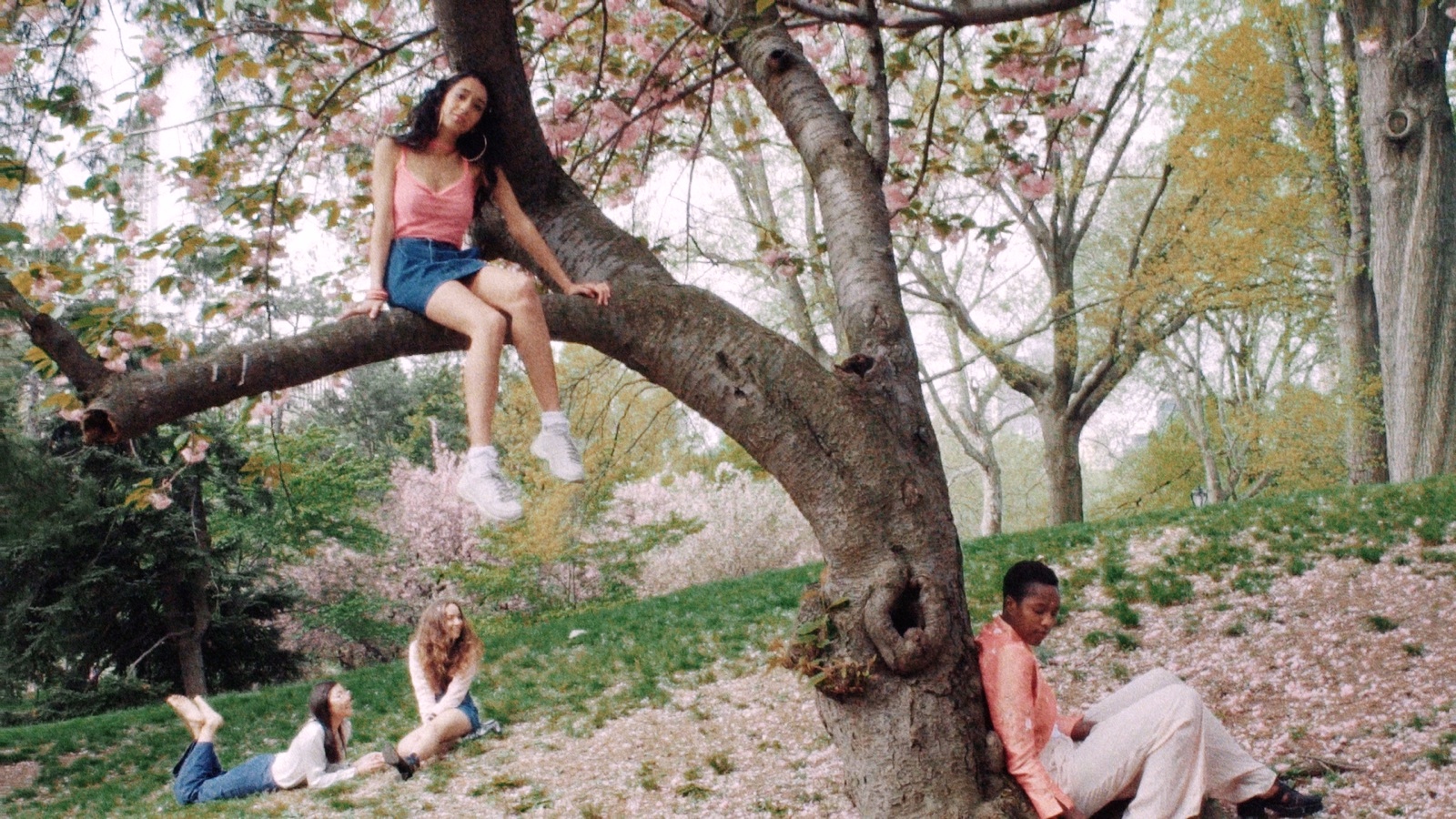Listening to Raveena Aurora, a New York-based R&B singer-songwriter, it’s easy to understand how artists like David Lynch and Hayao Miyazaki inspire her music. Like these filmmakers, the 24-year-old uses art to escape into a world of her own. She wields her airy yet disciplined voice over soulful 90s-inspired beats like a compass, guiding listeners through her thoughtfully constructed universe of nostalgia and tenderness. “When I was around eight or nine, I would lock myself in the bathroom for hours after school and just listen to my voice reverberating against the walls,” she recalls. “Writing came around 16—it was a total release and it helped me explore feelings I couldn’t talk about with other people, especially as a child of immigrants or as someone going through tough stuff at home.”
From a young age, music became a refuge for Raveena’s self exploration. Growing up in Connecticut, she devoured the sounds of jazz and soul legends like Ella Fitzgerald, Frank Sinatra, Sade, Amy Winehouse, D’Angelo, and Curtis Mayfield, making room for funky 70s artists like Prince. The smooth, sensual underpinnings of her tracks reveal an almost revivalist love for modern R&B. But, of course, the singer-songwriter takes every beat (which is most likely made by frequent collaborator and boyfriend Everett Orr) and makes it her own. With songs like “You Give Me That” and “Spell,” she moves closer to the spiritually aware and love-imbued space she strives to create for women of color like her. Each song is an open page, unafraid to explore the struggles of her life as well as her healing process.

This vision comes to a full fruition with her new music video “Sweet Time.” Her directorial debut, the visuals are straight out of a silky, strawberry-tinted daydream. Raveena and her crew of carefree women of color luxuriate in flowery clothing and lounge under a cherry blossom tree. It’s a gorgeous celebration of sisterhood, healing, and the power of inner magic. “I used a lot of the jewelry and clothing I saw my mom wearing that she brought over with her from India,” Raveena says. “That was a big part of the video, too.”
With her still untitled EP on the horizon and “Sweet Time” premiering today on i-D, we caught up with Raveena below.
You work mostly with producer Everett Orr. How did you guys begin collaborating?
We found each other through a friend who recommended it. From the first day we met, we knew it was a perfect match because we have a lot of the same influences, which are 70s and 90s R&B. It was also this thing of wanting to make a real sound together instead of a one-off, producer sends a beat and girl writes on it kind of thing. We wanted to shape something together and make something really personal. So that’s where it all started from and it’s been a really close relationship. We’re also in a relationship, so that adds another level to it. Everything we do is together and it’s definitely a really intimate process. I think there’s a kind of love woven into the music and I think it vibrates through. Maybe that’s just the romantic in me.
A lot of your music is about turning inward and doing that kind of work instead of searching for something outside of yourself. How did you get to this point in your writing?
I think it came from being forced to heal, going through really tough experiences, and not having many people around who could resonate with me. I had to look into myself and be my own healer and be my own source of strength. I learned about meditation, took up Buddhist philosophies, and I breathe and sit with my thoughts just so I can find some inner peace throughout the pain.
“Sweet Time” is your first self-directed music video. What was the process of making it?
That video was extremely D.I.Y. It was very intense because I kind of just delved into it and planned out every single detail. I self-funded it, so I would basically take on more hours at work on the weekends and came up with a $600 budget. I was like, “Can you work with this?” to the amazing cinematographer I worked with, [James Ronnko]. The women who worked with us were all very on-board with the idea immediately. They really made it special. I was really lucky to find such a passionate crew who really believed in the whole concept.
And what’s the concept behind the visuals?
The song is about self love. I think it’s extremely important for women of color to have self love, just for their own survival and growth as a community. I wanted to make a video that embodied that with women coming together to support and celebrate each other’s beauty and strength. I also wanted to do it through a dreamy, escapist lens. I wanted to portray these them in this feminine, sweet way because that’s not usually the roles we’re given as underrepresented women in the media — that the girl-next-door, Virgin Suicides quality that blonde women usually play. Showing women of color through that lens was really important for me.
How do you practice self love, especially as a woman of color in these tension-filled times?
I make sure that I have time to go on walks or just be alone with my thoughts, turn everything off, and just be present. I feel like when I’m in “go mode” and not stopping, I just get into bad habits of thinking or fall into negative spaces more easily. I think meditating is really important. Dancing in the moon with good, old music — that’s the best.
As an artist, what story are you trying to tell?
The story I’m trying to tell is one of healing. I want to make a community and safe space for women of color because that’s something that I didn’t have growing up. But I did have music. So, I think that if I can combine my love for music by also making that space for women, it could be really powerful and do good in the world. And I want to put out good quality stuff. I want everything to feel and look the best it can be and I want to push myself. But community is the answer in music — just making little pockets for people to connect with each other.
